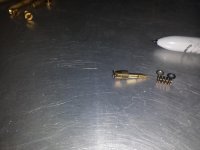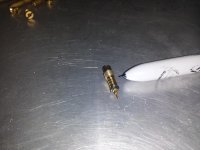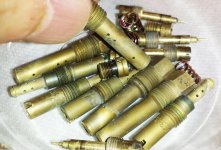Session 26: Pilots and Jets
Tonight I got the main jets out of the emulsion tubes without incident

The previously stubborn parts had soaked for about 24 hours in acetone to dissolve the varnish that was gluing the parts together. I removed them from their bath, slid emulsion tubes tube-end-first into the 7mm socket then used my best-fit driver to unscrew the main jets. Success! the parts separated easily.

With that out of the way I moved on to the pilot mixture screw. It is another brass part but this time with a cross slotted pattern a cruder version of a familiar Phillips shape. This was simple two perpendicular slots running across the head of the screw. In any case, though the Phillips driver was a crude fit it didn't matter as the screw were a very loose fit and the parts weren't bound with varnish - they turned easily. Online and the Haynes manual instructed to carefully count the number of turns the screws were from full insertion. To do this you simply count how many clockwise turns it takes until the screw stops and then jot down your findings. The manual says the NC35 should have a nominal setting of 1.625 (1-5/8) turns.
So my results were different from factory:
#1 = 1.5 turns
#2 = 1.75 turns
#3 = 2.0 turns
#4 = 1.75 turns
Shouldn't they all be the same or were they tuned by someone else previously? I hope they knew what they were doing. I think I'm supposed to reassemble to the same settings.
BTW I'm hoping someone tell me if these screws control air or fuel? Does loosening add whatever is controlled while tightening constricts?

Screw settings recorded, I extracted all the screws careful to keep them sorted lest they have subtle differences. I don't think they do though. It was interesting to see that the screws were actually small assemblies comprised of the brass screw, spring, small washer/shim and a puny rubber O-ring. Sliding the O-ring off freed the shim and spring. I think the Litetek carb kit came with replacement rubber and shims. I'll have to dig them up.
The screw appear a little dull and tarnished but mostly clean. I sorted them into their numbered baggies and will eventually ultrasonically clean them in batches. Making progress

 .
. 
 .
. 












 this tedious work makes my teeth chattery
this tedious work makes my teeth chattery




 Sigh, back to the cave .
Sigh, back to the cave .








